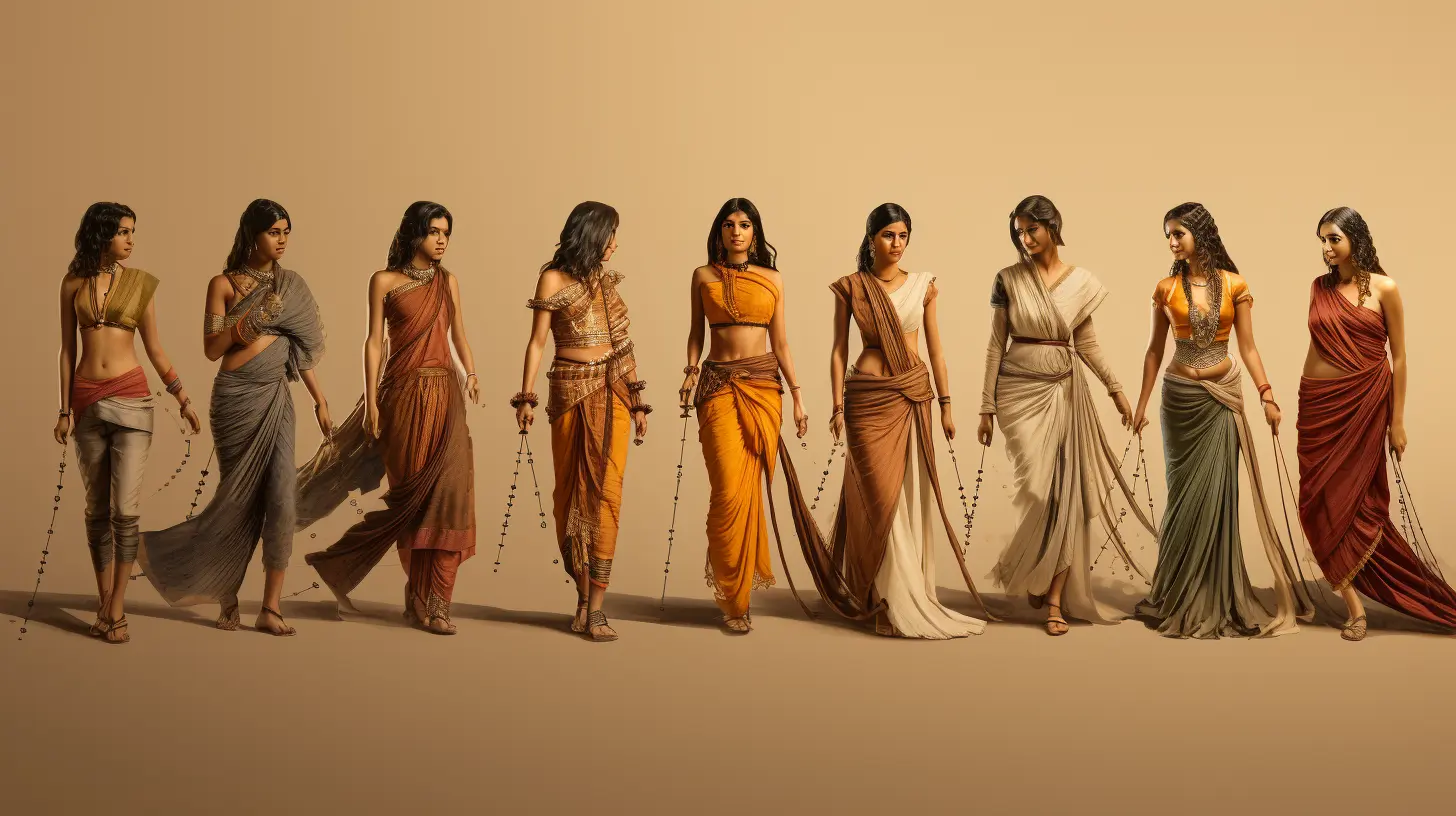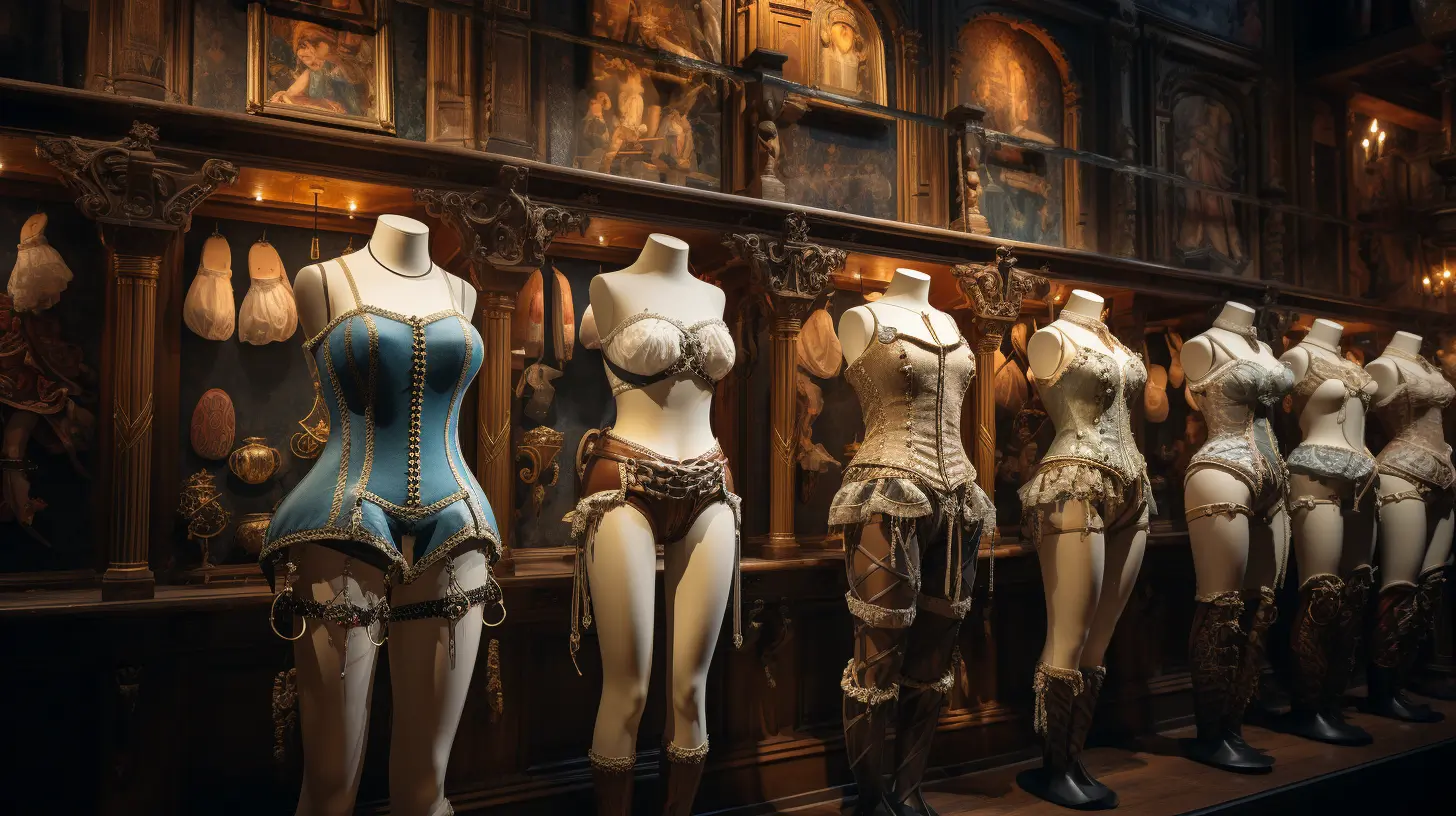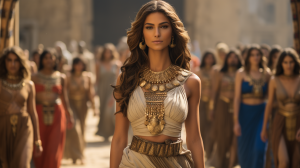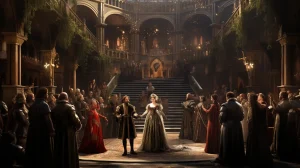
A Voyage Back in Time: Unveiling the Sartorial Splendors of the Indus Valley 🕰️👗
Hello, fashion history aficionados! Welcome to another fascinating installment where we journey through the annals of time to explore the intricate tapestry of clothing and identity. Today, we’re setting our virtual time machine to a destination filled with enigma and allure—the ancient Indus Valley. Have you ever wondered about the origins of draping styles, the symbolism behind vivid colors, or the cultural significance of ancient jewelry? Well, wonder no more! We’re diving into the mesmerizing world of Indus Valley fashion, an intriguing realm that speaks volumes about the society, traditions, and artistic brilliance of one of history’s earliest civilizations.
The Indus Valley Civilization, thriving around 3300–1300 BCE, was one of the world’s first urban cultures. It sprawled across what is today Pakistan and northwest India. Its people were known for their complex urban planning, intricate craftsmanship, and strong social organization. But what catches the discerning eye of a fashion historian like yours truly is the captivating story their clothing tells—a story interwoven with threads of social identity, cultural symbolism, and geographic pragmatism.
Why Fashion Matters 🌟
You see, fashion is not just about cloth and thread; it’s a language, a form of expression that holds a mirror up to the values, beliefs, and technological advancements of a civilization. Clothing choices can reveal a lot about social structures, traditions, and even the economic conditions of the time. That’s why a look at Indus Valley fashion is akin to leafing through a rich, vivid journal of humanity’s collective experience.
A Journey Awaits 🗺️
We’re about to embark on an illuminating journey. So sit tight and keep scrolling as we decode how the ancient Indus Valley’s people clothed themselves, how their fashion choices were influenced by their environment, and how the jewelry they wore wasn’t just ornamentation but a cultural revelation.
Stitched by Sun and Soil: How Geography and Climate Shaped Indus Valley Fashion ☀️🌱
Ah, the beauty of Nature! Just like the gentle strokes of a paintbrush in the hands of an artist like Bob Ross or the comforting words of wisdom from Mr. Rogers, the environment has a transformative impact on how a civilization dresses. This is especially true for the ancient Indus Valley, a land shaped by a rich tapestry of geographic and climatic factors. In this section, let’s cozy up and delve into how the lay of the land and the whims of the weather guided the threads and colors of Indus Valley fashion.
The Canvas: Geography’s Role 🌍
The Indus Valley Civilization sprawled across a vast region that included areas of modern-day Pakistan and northwest India. It was bounded by the lush Indus River and surrounded by mountains, forests, and deserts. This geographic diversity influenced not just the crops they cultivated but also the fibers they had available for clothing. Flax and cotton were popular choices, both of which are breathable and suited for a variety of climates. Whether it was the open plains or the bustling cities like Mohenjo-Daro and Harappa, the geographical terrain was a subtle yet significant co-designer in the creation of their attire.
Seasons of Style: The Climate Influence 🌦️
From scorching summers to cool, dry winters, the Indus Valley had a climate that varied dramatically. This climate prompted a clever, adaptable approach to dressing. For hot seasons, lighter fabrics and loose draping methods were preferred to enable better air circulation. For cooler times, layering became the norm, sometimes even integrating wool from the domesticated animals. Aesthetic choices, like embroidery or beadwork, were likely influenced by seasonal motifs, representing the cyclical dance of nature in wearable form.
The Palette: Color and Material Choices 🎨
Earth tones and vibrant dyes fashioned from plants like indigo and madder were often used. The presence of specific colors in their garments was not just an aesthetic choice but also a reflection of the natural resources available to them. Copper, another abundant material in the region, found its way into accessories, indicating a synergy between the available resources and fashion sensibilities.
Weaving Tales and Textiles: The Drapes of Identity in Indus Valley 🧵🎭
The way we dress tells a story. Whether we realize it or not, our fashion choices say something about who we are, where we come from, and sometimes, where we aspire to be. As Bob Ross would say, “We don’t make mistakes; we have happy accidents.” In a similar vein, the fashion in the ancient Indus Valley was a canvas, and every drape, fold, and stitch were like brush strokes that painted a vivid narrative. In this section, let’s take a gentle stroll down the lanes of Mohenjo-Daro and Harappa to explore how Indus Valley fashion was more than just clothes; it was identity expressed in textile form.
The Sartorial Syntax: Understanding Drapery 🗨️👗
In Indus Valley, clothing wasn’t just about covering oneself; it was an elaborate language. The drape of a garment conveyed social status, profession, and sometimes even the city of origin. Sculptures and carvings from the era depict a wide range of draping styles—some simple and functional, others complex and ornate. A scribe might wear a tightly wound drape to allow for ease of movement, while a priest or a noble might opt for a more intricate wrap, perhaps to signify a complex role within society.
The Everyday Ensemble: Function Meets Fashion 🌾👚
For the common folk, attire was predominantly functional but with a dash of flair. Cotton and flax were go-to choices for daily wear, often taking the form of wrapped skirts or tunics. These garments were simple to produce, easy to repair, and could be layered for versatility. While ornamentation was minimal, touches of embroidery or dyed patterns offered a whisper of individuality within a sea of functionality.
Jewelry: More Than Just Adornment 💍🌟
When it comes to jewelry, the Indus Valley was far ahead of its time. Pieces made of copper, gold, and semi-precious stones like lapis lazuli were popular. These weren’t mere decorations; they often served as talismans, trade commodities, or social indicators. Rings could signify marital status, while specific pendants may have had religious connotations. The language of jewelry in this ancient society was richly nuanced, adding another layer to their fashion vernacular.
Threads of Tradition: Craftsmanship in Indus Valley Textiles 🧶🎨
Like the soft strokes of a Bob Ross landscape, the craftsmanship of Indus Valley textiles was an art form—one that mirrored the harmonious balance between man and nature. Whether it was the hand-picked cotton bolls or the intricately spun threads, every element in Indus Valley fashion was a homage to the environment and to skilled human artistry. Let’s unravel this yarn of tradition, as we explore how textiles were more than mere fabrics; they were a testament to a way of life.
Cotton: Nature’s Gift to the Indus 🌿🎁
Cotton was not just a commodity; it was almost a cultural emblem for the Indus Valley Civilization. The fertile plains and the river valleys offered the perfect climatic conditions for cotton farming. Simple wooden tools were used to handpick the cotton, a testament to the symbiotic relationship between humans and their surroundings. This choice of fabric, soft yet resilient, also reflected the ingenuity of the people—a quality that extended into their tailoring techniques.
Spinning Yarns: The Wheel of Skill 🎡🧵
The charkha, or the spinning wheel, was more than just a tool—it was a symbol of skill and tradition. Its manual operation required expert hands, as raw cotton was spun into usable thread. The process was intricate, often involving multiple people and taking several days to complete. This thread would eventually find its way into the looms, where it was woven into cloth. The laborious yet mindful practice showcased the craftsmen’s dedication to their art, producing textiles that were as much about skill as they were about aesthetics.
Coloring the Canvas: Dyes and Designs 🎨👗
The use of natural dyes added another layer of craftsmanship to Indus Valley textiles. From the rich indigo blues to the fiery madder reds, these colors were sourced from plants and minerals. Patterns weren’t just random or merely decorative; they often told a story or followed geometrical symmetry that could be linked back to societal norms or religious beliefs. The coloring process itself was an elaborate ritual, involving several stages of dyeing, drying, and sometimes, re-dyeing to achieve the desired hue.
Metal & Stone: Adornments that Speak Volumes 💍🗿
In the gentle neighborhood of Mr. Rogers, the importance of uniqueness and individual expression was celebrated. The Indus Valley people, too, had their way of vocalizing identity, not through puppetry or song, but through a captivating array of jewelry and adornments. Their intricate works in metal and stone are awe-inspiring relics that convey volumes about their skills, values, and social nuances. Come with me, let’s wander through the “jewelry box” of this ancient civilization.
Heavenly Bodies: The Cosmic Influence 🌙⭐
In the realm of Indus Valley jewelry, celestial bodies had a star-studded role. Necklaces, anklets, and even hairpins often featured symbols of the sun, moon, and stars. This wasn’t mere decoration; it was a reflection of their understanding of astronomy and perhaps an attempt to align human life with cosmic forces. Just as we find inspiration in the natural world to breathe life into paintings, the ancient artisans drew from the heavens to create pieces of wearable art.
The Medium and the Message: Material Choices 🪙📜
The materials chosen for jewelry in the Indus Valley weren’t arbitrary. Gold, silver, and semi-precious stones like carnelian and turquoise were popular. These choices were not just a matter of aesthetics or availability; they were deeply rooted in their belief systems and social structures. For example, gold often adorned the elite, making it a status symbol, whereas simpler materials like shell and bone were accessible to the masses.
Encoded Elegance: Symbolism and Patterns 🎭🌀
Ah, the patterns! If you were to lay out an assortment of Indus Valley jewelry, you’d be fascinated by the diversity of patterns. Spirals, concentric circles, and floral motifs were more than mere designs; they carried symbolic meaning. Just like Mr. Rogers carefully selected each word to convey kindness and inclusivity, these patterns were intricately chosen to express beliefs, convey status, or protect against perceived evils.
Shapes and Drapes: The Architecture of Clothing 🧥🎨
Life is full of intricacies and complexities, and what we choose to wear can be one of its most visible and intricate expressions. In the Indus Valley, the concept of clothing was akin to a silent symphony—each drape, fold, and stitch played its part in this grand composition. Let’s delve into the folds and the fabric of the Indus Valley wardrobe, shall we?
The Language of Linen: Fabric Choices 🌿🎐
Choosing a fabric isn’t merely about texture or durability. In the Indus Valley civilization, fabric choices were guided by climate, social standing, and even spirituality. Cotton was the crown jewel, appreciated for its breathable texture, especially in hot and humid conditions. Different grades of cotton and other natural fibers were available, creating a nuanced choice that spoke volumes about the wearer.
Consciously Wrapped: Draping Styles 🌪️🎭
When it comes to clothing, how you wear it can be as revealing as what you wear. Draping was an art form here, carefully executed to display rank, occasion, or even mood. The draped garments often resembled what we’d consider a sari or a dhoti today. It’s not just about covering the body; it’s about expressing an identity that goes beyond skin deep.
Utility by Design: Functionality Meets Fashion 🛠️💃
Even in ancient times, fashion wasn’t just about looking good; it was also about being practical. Pockets, seams, and even the length and layering of the garments were meticulously planned. Such functional features show that fashion and practicality were twin pillars in the architectural design of Indus Valley clothing.
Threads of Significance: The Semiotics of Dress 🎭🔮
Clothing is not just a physical layer; it’s a psychological one too. As we decode the garb of the Indus Valley civilization, let’s remember that each stitch and color choice carries a meaning. This realm extends beyond mere aesthetics to communicate intricate narratives.
The Palette of Prestige: Color Choices 🌈🎨
In any civilization, color isn’t just a visual experience—it’s a deeply emotional and sociopolitical one. In the Indus Valley, the colors were chosen not just to please the eye, but also to convey particular emotions or statuses. For instance, red symbolized passion and was often used in ceremonial garb, whereas white indicated purity and was typically worn by those engaged in religious rituals.
Stitches in Time: Embellishments and Detailing ✨📿
One can argue that the beauty of a garment lies in its details. Embroidery, beadwork, and even the specific type of stitch used conveyed messages about the wearer’s identity. For instance, the inclusion of tassels or intricate beadwork was often a sign of higher social status, as these required extra time and specialized skills to create.
Wearable Narratives: Symbols and Motifs 📜🌿
Symbols and motifs in clothing served as visual narratives. Animals, celestial bodies, and other natural elements often made their way into the design, each carrying a story or a message. These not only added artistic flair but also conveyed the wearer’s beliefs, wishes, or aspirations.
The Fabric of Society: Clothing and Social Dynamics 🏛️🧵
As we unravel the threads of history, it becomes increasingly evident that clothing in the Indus Valley was not an isolated element, but an integral part of broader social structures and institutions. The fabric choices, designs, and even the method of draping were deeply rooted in societal norms, and they provided an external expression of an intricate internal framework.
The Loom of Classes: Hierarchy and Attire 🏰👑
The Indus Valley civilization had a complex social structure that was vividly reflected in the clothing choices of its inhabitants. The elite had the luxury of adorning themselves in finely spun cotton and silk, often dyed in vibrant colors and embroidered with gold thread. In contrast, the working class primarily wore simpler, more utilitarian garments, usually made of hemp or other coarse fibers. These garments were often more practical, but less colorful or adorned, which visually reinforced the societal divisions.
Garments as Genders: The Clothes That Made the Man, or Woman 🚻🎭
Clothing also played a role in expressing gender identity, which was strictly defined within the social constructs of the time. Women often wore intricate sarees or long flowing gowns adorned with jewels and embroidered motifs. Men, on the other hand, were often seen in dhotis or turbans, styled in a way to symbolize their role in society. This not only functioned as a marker of biological differences but also as a mechanism of enforcing social roles and expectations.
Faith Woven In: Religious Overtones in Apparel 🛐🔔
Religion and spirituality were closely intertwined with daily life in the Indus Valley civilization. Many garments featured symbols or motifs that were religious in nature, such as depictions of gods or sacred animals. These were more than mere decorations; they were expressions of devotion or reverence, and sometimes even a sign of belonging to a particular religious sect.
Ephemeral Elegance: The Evolution of Indus Valley Fashion Over Time 🕰️👗
As one traverses the corridors of time, one is presented with the inexorable truth that change is the only constant. In the annals of the Indus Valley Civilization, this mutability is vividly etched in the sartorial choices of its inhabitants. To study the changing fashion is to explore a living, breathing document that registers every societal fluctuation, from political upheavals to technological advances and climatic changes.
From Loincloths to Layering: Early Adopters of Sophisticated Garments 🍃👘
Originally, the inhabitants of the Indus Valley wore uncomplicated garments, often fashioned from a single piece of cloth that was wrapped around the body. As the civilization grew in wealth and complexity, so did the intricacy of its clothing. Layering became a trend, with shawls, scarves, and cloaks making an appearance. Thus, fashion became a litmus test of the civilization’s advancement.
The Tint and Tone of Time: Textile Dyeing Techniques Through the Years 🎨🧶
One of the most illuminating advancements in Indus Valley fashion was the mastery of textile dyeing. Initially relying on natural hues, the civilization gradually developed a repertoire of vibrant dyes. Colors came to carry symbolic weight; certain shades were reserved for auspicious occasions, others denoted social rank or occupation. With the arrival of indigo, saffron, and other exotic pigments, fashion entered a veritable renaissance.
Fashion Meets Function: Material Innovation in Clothing 🌿🔬
Equally noteworthy was the evolution in materials. What began with rudimentary plant fibers gradually incorporated animal hides and luxurious textiles like silk and cotton. This shift was not merely cosmetic but also utilitarian, offering enhanced durability, comfort, and protection against the elements. Furthermore, the innovation in materials reflected broader technological and trade developments within the civilization.
A Stitch in Time: Reflecting on the Indus Valley’s Fashion Legacy 🧵⏳
Welcome to the final lap of our in-depth journey through the annals of Indus Valley fashion. We’ve unfurled the tapestry of sartorial history, dissected trends and innovations, and now we turn the lens toward an equally important facet: the lasting impact of these evolutions. The final threads are often the most intricate, and as we pull them together, we uncover the enduring legacy that this ancient civilization has imprinted upon our modern fashion tapestry.
Timeless Aesthetics: The Indus Valley Influence on Contemporary Styles 🌱👗
It’s astonishing to observe how the sartorial choices from thousands of years ago continue to influence modern fashion. The art of layering, for instance, prevalent in the Indus Valley, has survived the millennia and is evident in everything from traditional South Asian attire to Western winter wear. It’s like a conversation across ages; the old informing the new in a never-ending dialogue.
Unraveling the Threads: Global Cultural Exchanges 🌏🔄
Even if you’ve never stepped foot near the Indus Valley, its fashion has likely touched you in some form. Through intricate trade routes and cultural exchanges, elements of Indus Valley style have woven themselves into the global fabric. Dyeing techniques, for instance, have been shared, adapted, and repurposed across continents. It’s not just clothing; it’s a passport to a myriad of global connections.
Stitched in History: The Sartorial in Societal Memory 🎭📜
Clothing isn’t just material; it’s a tapestry of stories, traditions, and memories. Every garment holds the echoes of its creators, wearers, and even its era. The Indus Valley is no different. Its sartorial innovations have become historical markers, invaluable to researchers and historians seeking to understand the era. So, when you wear a garment influenced by this ancient civilization, you’re wearing a slice of history.
And there you have it, folks. The broad strokes and fine details of the Indus Valley’s fashion tapestry, all unfurled for your perusal. The tapestry may have many threads, but each is invaluable in creating the intricate and beautiful whole.
The Final Hem: Weaving Together the Threads of the Indus Valley 🌠
Well, here we are, at the end of an incredible journey—a sartorial voyage that not only took us back in time but around the world. Just like the essential elements of a fine dish or the last chapter of an engrossing novel, it’s the finale that makes you appreciate the sum of its parts. Let’s tie off this tapestry with as much finesse as we’ve applied throughout.
The Echo of A Thousand Looms: A Retrospective 📜🎵
We’ve discussed fashion as a language, a kind of universal code. From the Indus Valley, that language has spread its lexicon globally. The resonance of a thousand ancient looms is still heard today in every machine-knit sweater, every embroidered scarf, and yes, even in your go-to denim jeans. There’s a profound satisfaction in knowing that the same threads that once adorned the people of an ancient, thriving civilization might be woven into the fabric of your own life.
Chasing Time: The Relevance of Antiquity ⏳🌍
Fashion is always about the here and now, right? But it’s not just the whims of the season that dictate what we wear. The past has a persistent way of influencing the present, be it in the rebirth of flared jeans or the ever-popular choker. The Indus Valley, in its quiet yet persistent way, nudges us to look beyond the fashion cycle’s ebb and flow and pay homage to timeless elegance.
A Lifelong Thread: Final Thoughts and Encouragements 🗺️👣
Let’s not kid ourselves; this isn’t just about clothes. This is about the human journey and the wonderful kaleidoscope of expression we’ve crafted over the millennia. What you wear isn’t just a statement of style but a passport into a rich, cultural tapestry. So, take this knowledge, celebrate it, and let it inform your choices—be it in fashion, history, or the grand pursuit of understanding the human story.
And there you have it. Our woven narrative has come full circle. I hope this tapestry has added a few more intricate designs to the fabric of your understanding.








